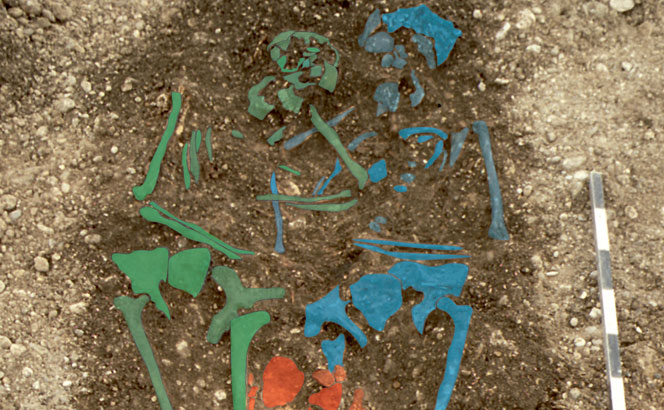
One branch of a deadly pathogen’s family tree may have ended centuries ago, but from its ancient traces researchers can read a lineage with links to the modern world.
An international team of scientists has discovered that two of the world’s most devastating pandemics—the plague of Justinian and the Black Death, each responsible for killing as many as half the people in Europe—were caused by distinct strains of the same pathogen.
The strain that helped bring an end to the Roman Empire faded out about 1,500 years ago on its own. But the other, which flourished 800 years later, led to worldwide re-emergence in the late 1800s and is still with us today, killing thousands each year. The findings suggest a new strain of bubonic plague could emerge again in humans in the future.
“This is the oldest bacterial genome ever produced,” said Dave Wagner, an associate professor in the Center for Microbial Genetics and Genomics at Northern Arizona University. “We were able to go back in time and find something that went extinct.”
Wagner said the Justinian strain, which earlier research traced to having its origins in Asia, lies “smack between” two groups that are still found in China. “So that’s pretty interesting that it moved all the way to Europe and went extinct. It could still be out there somewhere between Europe and China but we haven’t seen it yet.”
The plague of Justinian struck in the sixth century and is estimated to have killed between 30 and 50 million people— virtually half the world’s population as it spread across Asia, North Africa, Arabia and Europe. The Black Death struck about 800 years later with similar force, killing 50 million Europeans between 1347 and 1351.
Researchers from NAU provided the overall plague expertise on the project, while those in the lab at McMaster University in Canada sequenced minuscule plague DNA fragments from the 1,500-year-old teeth of two victims of the Justinian plague, buried in Bavaria, Germany. The University of Sydney contributed expertise on the pathogen’s molecular clock—a method used to infer when different events in the evolutionary history of a species have taken place. And colleagues from several institutions in Munich, Germany—including the State Collection for Anthropology and Paleoanatomy and the Bundeswehr Institute for Microbiology—provided the samples.
The team reconstructed the genome of the oldest strain of Yersinia pestis, the bacterium responsible for the bubonic plague, and compared it to a database of genomes of more than one hundred contemporary strains.
The results are currently published in the online edition of The Lancet Infectious Diseases. They show the strain responsible for the Justinian outbreak was an evolutionary ‘dead-end’ and distinct from strains involved later in the Black Death and other plague pandemics that would follow.
The third pandemic, which spread from Hong Kong across the globe—including all the way to Arizona—is likely a descendant of the Black Death strain and thus was much more successful in evolutionary terms than the one responsible for the Justinian Plague.
Although the rise and fall of the Justinian plague suggests that a similar emergence could happen again with a new strain, other factors render the scenario unlikely, Wagner said.
“We don’t think we’re going to see new large-scale plague pandemics. Not because the organism has changed—it’s just as deadly as it always was—but humans have changed,” Wagner said. Improvements in hygiene, particularly the limiting of rat populations in cities, and the emergence of antibiotics would limit the effective spread of the pathogen.
Paul Keim, a Regents’ Professor and the Cowden Endowed Chair of Microbiology at NAU said that “Plague has been circulating through civilization for at least 1,500 years and characterizing this ancient genome allows us to understand how diseases arise and then spread from continent to continent—even to locations in Arizona.”



